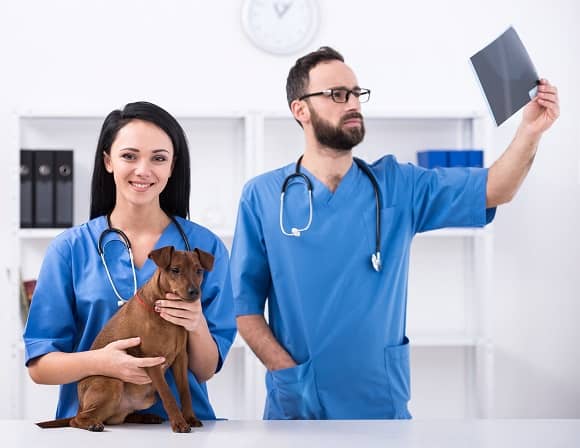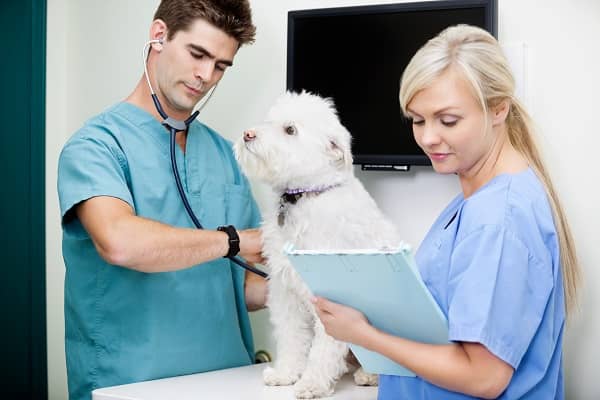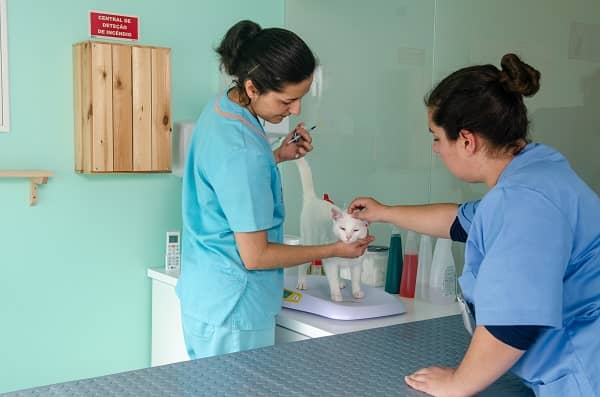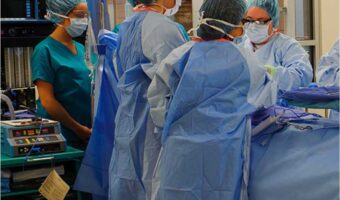Vet Tech Program Overview
NEIT offers one of the most comprehensive online VET Tech Programs for students seeking to make a fulfilling career as a veterinary technician. The Bachelor of Science in Veterinary Technology degree is the final six terms of our 2+2 vet tech program.
This online veterinary technician program is ideal for students who wish to earn a bachelor’s degree and focus on a deeper understanding of topics learned at the associate level. Students can complete their bachelor’s degree full-time after obtaining an associate degree or part-time while working in the veterinary practices field.
In the bachelor program, students study advanced topics in areas such as practice, administration, anesthesiology and pain management, emergency and critical care, nutrition, dentistry, behavior, human-animal bond, exotics, internal medicine, and laboratory animal medicine at our veterinary technician school.
NEIT also offers additional courses on the application of communication and writing that can deepen the understanding of our graduates. The final two terms of the curriculum will require a practicum in the student’s particular area of advanced interest.
Upon completing this degree, a student can kickstart a promising career in veterinary technology and work in animal hospitals, the pet care industry, animal care, wildlife facilities, and laboratories.
Read MoreFull Description
The Bachelor of Science Degree in Veterinary Technology prepares students to take up jobs as entry-level veterinary technicians or technologists. Our vet tech students complete a thorough educational foundation consisting of coursework and lab work during this program.
Our graduates learn about the managerial, critical thinking, and clinical professional skills necessary to work as effective veterinary healthcare team members with our comprehensive veterinary technician education.
Veterinary technology is the science and art of providing professional support to veterinarians. Veterinary technician professionals offer professional health care for animals under the supervision of a veterinarian. Becoming a technician presents fantastic career opportunities, especially if you love working with animals.
A veterinary technician can take up job responsibilities such as surgical assisting, anesthesiology, radiology, caring for hospitalized patients, administering vaccines and medications, and dental prophylaxis.
Other responsibilities include collecting specimens and performing clinical laboratory procedures, client education, physical examination, patient history, and office/hospital management. A Vet tech cannot diagnose, prescribe, or perform surgery.
Students learn veterinary concepts and appropriate modeling of professional and ethical conduct throughout the curriculum. Our planned laboratory and clinical practice experiences help expand student knowledge and lead to proficiency in task-specific essential and recommended skills for entry-level veterinary technician jobs.
The Bachelor of Science Degree curriculum consists of advanced topics that students pursue after their veterinary technician associate degree.
Throughout NEIT’s vet tech program, our graduates will learn topics such as human-animal bonds, small animal internal medicine, animal behavior, emergency medicine and critical care, clinical animal nutrition, advanced anesthesia and pain management, advanced dentistry, emergency care, and advanced animal medicine.
Our online program curriculum also consists of supplementary subjects such as Law and ethics in veterinary medicine, human resource management, public health course, customer relations, and sales to equip our students with the necessary management skills essential for becoming a successful veterinary assistant.
These topics will help aspiring technicians learn the laws, rules, and regulations governing veterinary medicine, animal care, and pharmaceuticals.
Our graduates will learn the process of bonding, emotional, zoonotic diseases, food supply safety, epidemiology of conditions, and the prevention/control/eradication of public health threats in veterinary medicine.
After pursuing their degree, students will know the principles, diagnosis, and treatment of common diseases and conditions involving small animals.
They will also be proficient in domestic animal behavior, behavior plans, animal learning, cognition, and essential psychopharmacology. Students can learn the various aspects of nutrition, identify nutrition sources and functions, interpret pet food labels and prescription diets.
Advanced topics principles and theory in small animal emergency and critical care medicine and common emergencies will equip our graduates to assist in treatment at all stages of care. Students will receive training on specific organ system disorders and the necessary advanced nursing care required to treat them. Students will learn how to monitor and evaluate these patients and communicate this assessment to the veterinarian.
Accreditation for the Bachelor of Science program is pending approval. The Associate of Science in Veterinary Technology program is accredited by the American Veterinary Medical Association’s Committee on Veterinary Technician Education and Activities(AVMA-CVTEA) to educate veterinary technician aspirants.
American Veterinary Medical Association (AVMA)
Committee on Veterinary Technician Education and Activities (CVTEA)
Education and Research Division
1931 N. Meacham Rd., Suite 100
Schaumburg, IL 60173-4630
800-248-2862 ext. 6624
www.avma.org
The American Veterinary Medical Association Committee on Veterinary Technician Education and Activities (AVMA-CVTEA) accreditation program helps recognize veterinary technician training programs capable of developing proven assistants for veterinarians and assisting in developing such programs.
Although it is not mandatory, we advise students to take the Veterinary Technician National Exam (VTNE) or be a Certified Veterinary Technician (CVT) to enroll in our program.
The Veterinary Technician National Examination (VTNE) is an examination that evaluates entry-level veterinary technicians’ competency to practice and become credentialed. To take the VTNE, you must be a graduate of an American Veterinary Medical Association (AVMA)accredited vet tech program.
The mean three-year national VTNE pass rate has been 70.31 percent for first-time takers. NEIT’s education programs in veterinary technology equip students with the necessary vet technician experience and knowledge to take up the VTNE and other certification exams.
Potential Career Opportunities
Veterinary technologists work in more advanced research-related jobs. They usually work under the guidance of a scientist or veterinarian. Some technologists work in private clinical practices and assist in sample tissue preparation for the examination. They also record genealogy, weight, diet, and signs of pain in animals.
A Veterinary technician generally assists in a laboratory for diagnostic tests such as a urinalysis. They also help talk with pet owners and explain a pet’s condition or administer medication dosages at appropriate times.
The unique aspect of this comprehensive veterinary technician program is that our graduates can apply for employment opportunities nationally.
Some common employers include veterinary clinics and hospitals, teaching institutions, research facilities, pharmaceutical companies, rescue organizations, agricultural operations, boarding kennels, zoos, and wildlife rehabilitation.
The National Association of Veterinary Technicians in America (NAVTA) recognizes 11 specialty roles for vet techs. Individuals pursuing a career can opt for the following specialized job roles after completing their vet tech degree:
Clinical Pathology Vet Technologist
Clinical Practice Vet Tech
Emergency And Critical Care Vet Tech
Equine Vet Tech
Internal Medicine Vet Tech
Veterinary Behavior Technician
Veterinary Surgical Technician
Veterinary Dental Tech
Veterinary Tech Anesthetist
Veterinary Nutrition Tech
Zoo Vet Tech
FAQ
-
Can you become a veterinary technician online?
Students can become a vet tech online after pursuing a veterinary technology distance learning course such as an associate’s or bachelor’s degree in veterinary technology.
Such courses are highly convenient as they give you the flexibility to learn at your own pace without having to sacrifice your current job obligations.
-
How long does it take to pursue online vet tech programs?
Online veterinary technician programs generally require around two years for a veterinary technician associate degree after obtaining your high school diploma or GED. Bachelor’s degree programs can take additional two years. The total time required depends upon the number of credit hours you opt for each term.
-
How much does a veterinary technician with a bachelor’s degree make?
According to the Bureau of Labor Statistics (BLS), the median annual salary for veterinary technicians and technologists was $36,260 in May 2020. The top 10 percent of professionals in this field earned more than $52,410 per year. BLS predicts that there will be 16 percent job growth for veterinary technologists from 2019-2029.
-
What is the best online school for vet tech?
Schools such as NEIT, which offer comprehensive education courses, online programs, and lab training in veterinary sciences, are the best for pursuing a vet tech career.
Some parameters that can help you pick the best vet tech school are American Veterinary Medical Association (AVMA) and Veterinary Technician Education and Activities (CVTEA) accreditation status, curriculum, tuition fee, credit requirement, and course flexibility.








